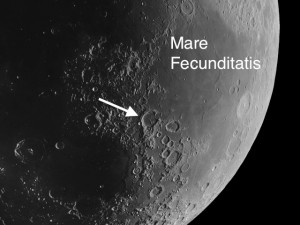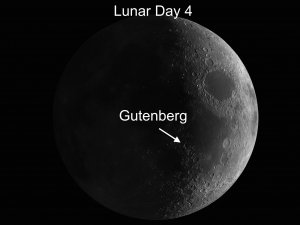The week of March 7-13 takes us from lunar Day 28 (New Moon) through Day 5. Lunar Days 1 and 2 aren’t worth the bother (wait until just after Full Moon when these same features will have risen out of the low horizon murk). From Day 4 on things become quite interesting.
 This week we will highlight the crater Gutenberg on March 12th.
This week we will highlight the crater Gutenberg on March 12th.
Gutenberg Crater: Lunar Highlight the Week of March 7
 • Gutenberg: [SE/K14] Gutenberg crater is not only of historical importance because of its namesake, it shows an unusual sequence of crater development. Gutenberg is a large crater (45 mi. in diameter) that is intruded upon by a smaller crater (12 mi. in diameter–Gutenberg E) on its eastern wall. So far so good. But take a close look at the crater immediately adjoining it to the south (Gutenberg C). These craters have violated the usually dependable rule that newer craters are smaller than the older craters they have intruded upon. Gutenberg C is the older crater, while the larger Gutenberg is the interloper.
• Gutenberg: [SE/K14] Gutenberg crater is not only of historical importance because of its namesake, it shows an unusual sequence of crater development. Gutenberg is a large crater (45 mi. in diameter) that is intruded upon by a smaller crater (12 mi. in diameter–Gutenberg E) on its eastern wall. So far so good. But take a close look at the crater immediately adjoining it to the south (Gutenberg C). These craters have violated the usually dependable rule that newer craters are smaller than the older craters they have intruded upon. Gutenberg C is the older crater, while the larger Gutenberg is the interloper.
Another item of interest is the small bowl-shaped crater on the southwest rim (Gutenberg A). The rim shadow on a rounded bowl-shaped floor will appear as a smooth arc. If the floor is flat because it has been partially filled in with boulders that have tumbled down the crater’s walls, the shadow will be truncated (i.e., the apex will be squared off). Can you tell if the floor of Gutenberg A is bowl-shaped or flat?
Total Eclipse of the Sun by the Moon and Pleiades Stars: More Lunar Highlights the Week of March 7
OF ADDITIONAL INTEREST:
- Total eclipse of the Sun by the Moon on Tuesday, March 8th, in parts of Indonesia and the Pacific at 0:17 to 3:37 Universal Time. The eclipse is partial in Hawaii during the hour before sunset.
- On Saturday, March 12th, the Moon is 15° below the Pleiades, one of the few open clusters you can see with the naked eye. They are best observed through binoculars. How many of the Pleiades stars can you see with the naked eye? Those with good eyesight (and some luck) can see six. The world naked-eye record-holder for the Pleiades is Walter Scott Houston who sighted 18 stars in 1935. (There is actually a total of 1,000 stars in the cluster). Our Sun belonged to such a cluster at one time, but all of its siblings have long since been pulled away by the gravitational pull of the rest of the galaxy.
The Japanese word for Pleiades is “Subaru”, which is why you see an emblem of a star cluster on the back of Subaru cars.
======================
It is highly recommended that you get a copy of Sky and Telescope’s Field Map of the Moon, the very finest Moon map available for use at the telescope. It is available for $10.95 at www.skyandtelescope.com and on Amazon. All features mentioned in this blog will be keyed to the grid on the Field Map and will look like this: Plato: [NW/D9]
Credits:
Courtesy of Gray Photography of Corpus Christi, Texas
Lunar photos: NASA / USGS / BMDO / LROC / ASU / DLR / LOLA / Moon Globe. Used by permission
- Hippalus Rilles on the Moon - April 15, 2024
- Moon Crater Janssen: How New Moon Craters are Superimposed on Top of Older Craters - April 8, 2024
- Crater Longomontanus on the Moon - April 1, 2024